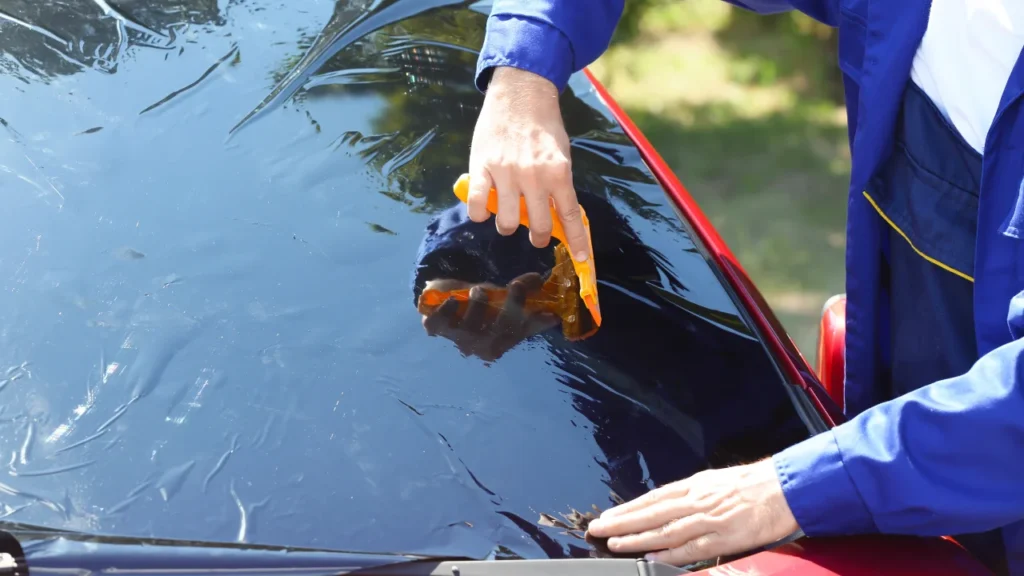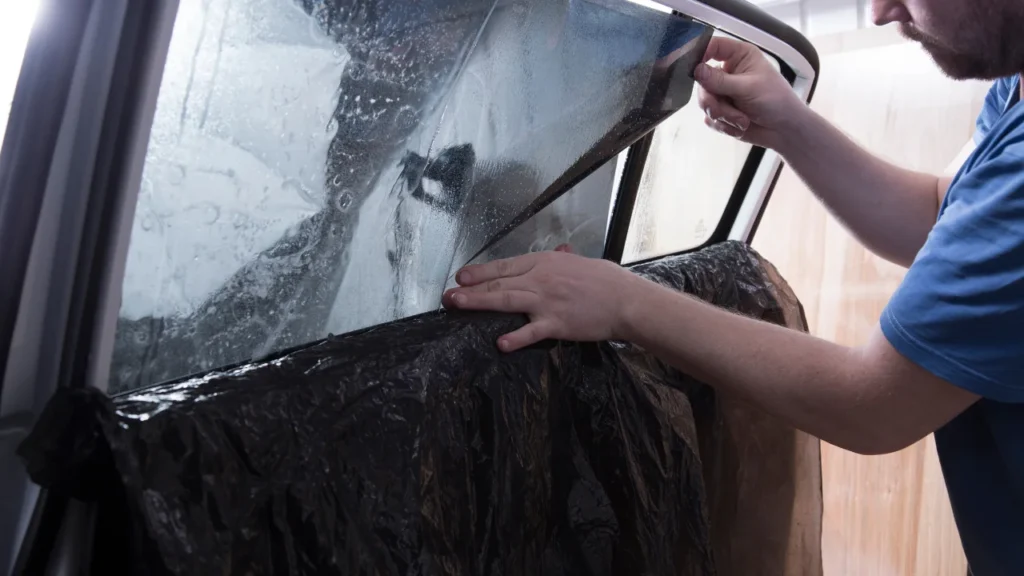Table of Contents
France’s car window tinting law carefully balances privacy and safety needs, specifying the light transmittance percentage allowed on each vehicle window to ensure safe visibility. The front windshield requires at least 70% light transmittance, any tint reducing visibility by more than 30% results in non-compliance and potential penalties.
1 Understanding Tinting Laws in France

In France, the legal tint limit refers to the maximum level of light transmittance allowed through car windows. Light transmittance is measured as the percentage of visible light that can pass through the window. The inverse relationship between tint and percentage is such that the lower the percentage, the darker the tint.
To comply with French regulations, it is important to know the specific requirements for each window of your vehicle. The legal limit for window tint varies depending on the type of window:
- Front Windshield: The front windshield is strictly regulated, and it must allow at least 70% light transmittance. This means that the tint applied to the front windshield should not reduce visibility by more than 30%.
Expanding on this, the front windshield is crucial for driver visibility and safety. It is the primary window through which a driver views the road ahead. Therefore, French regulations require that the front windshield allows at least 70% light transmittance to ensure clear visibility. This ensures that drivers have a wide field of vision, especially during nighttime or low-light conditions. A tint that reduces visibility by more than 30% is considered non-compliant and can lead to penalties.
- Front Side Windows: The front side windows, including the driver and passenger windows, must allow at least 70% light transmittance as well. This is to ensure clear visibility for the driver and passengers, especially during nighttime or low-light conditions.
Expanding further, the front side windows play a significant role in driver and passenger visibility. These windows allow for a wide field of vision, enhancing safety while driving. To maintain clear visibility, French regulations require that the front side windows allow at least 70% light transmittance. This helps drivers to see the road clearly and avoid any potential hazards. It is important to note that this requirement applies to both the driver and passenger windows, as passenger safety is equally important.
- Rear Side Windows: The regulations for rear side windows are less strict compared to the front side windows. While there is no specific percentage mentioned in the law, it is generally recommended to maintain a light transmittance level of around 30% to 50%, striking a balance between privacy and safety.
Expanding on the regulations for rear side windows, French law does not specify a specific percentage for light transmittance. However, it is generally advised to maintain a tint level of around 30% to 50% to strike a balance between privacy and safety. This allows for some level of privacy for passengers, while still ensuring sufficient visibility for the driver. It is important to note that excessively dark tints may hinder rearward visibility, especially at night, which can be dangerous and may result in penalties.
- Rear Windshield: Similar to the rear side windows, there is no specific percentage mentioned for the rear windshield. However, it is advisable to maintain a light transmittance level similar to the rear side windows, around 30% to 50%.
Expanding further, the rear windshield is also subject to similar recommendations as the rear side windows. While the law does not specify a specific percentage for light transmittance, it is advisable to maintain a tint level of around 30% to 50%. This ensures a balance between privacy and safety, while still allowing for sufficient visibility for the driver. Excessive darkness on the rear windshield may obstruct the driver’s view, particularly during nighttime or low-light conditions.
2 Penalties for Non-Compliance
Failure to comply with the legal tint limit in France can result in penalties and fines. Law enforcement officers have the authority to enforce these regulations during routine vehicle inspections or traffic stops. The penalties may vary depending on the seriousness of the violation and may include:
- A fine ranging from 135 euros to 750 euros, depending on the degree of non-compliance.
- Points are deducted from the driver’s license. Too many traffic violations can result in the suspension or revocation of your driver’s license.
- An obligation to remove the tint film within a specified timeframe. Non-compliance may result in further fines or penalties.
It is important to note that these penalties are subject to change, and it is always recommended to stay updated with the latest regulations to avoid any legal consequences.
3 Tinting Exceptions and Additional Information
While there are strict regulations regarding tinting in France, there are a few exceptions and additional information worth noting:
- Medical Exemptions: In some cases, individuals with specific medical conditions may be permitted to have darker tints on their windows. However, this exemption requires a medical certificate and must be approved by the appropriate authorities.
Expanding on medical exemptions, individuals with certain medical conditions that require increased protection from sunlight may be eligible for an exemption from the standard tint limits. However, this exemption is not granted without proper documentation. A medical certificate must be obtained, and it must clearly state the medical condition that necessitates the darker tint. Furthermore, this certificate must be approved by the appropriate authorities to ensure the legitimacy of the exemption.
- Factory-Tinted Windows: Vehicles with factory-tinted windows, which were installed by the manufacturer, already comply with the legal tint limit. It is important to ensure that the tint level meets the regulations, as some factory tints may be darker than the legal limit.
Expanding further, vehicles that come with factory tinted windows are already compliant with the legal tint limit in France. These windows are installed by the manufacturer and are designed to meet the specified regulations. However, it is essential to verify that the tint level of the factory windows falls within the legal limits. Some vehicles may have factory tints that are darker than the allowed percentage, which can result in penalties if found non-compliant during inspections.
- Inspection Stations: When registering a vehicle in France, it must undergo a technical inspection at an authorized station. During this inspection, the tint level is checked, among other essential vehicle components. If the tint is found to be non-compliant, the vehicle owner may be required to remove or adjust the tint before the registration is approved.
Expanding on the role of inspection stations, it is important to emphasize that tint levels are checked during the mandatory technical inspection when registering a vehicle in France. Authorized inspection stations conduct thorough inspections to ensure compliance with various vehicle regulations, including tint limits. If the tint is found to be non-compliant, the vehicle owner will be notified and required to remove or adjust the tint before the registration process can be completed. This emphasizes the importance of adhering to the legal tint limit to avoid any complications during the registration process.
- Temporary Tints: Temporary tints, such as window shades or sun blinds, are allowed as long as they do not obstruct the driver’s view and can be easily removed when necessary.
Expanding further, temporary tints, such as window shades or sun blinds, are permitted in France as long as they do not obstruct the driver’s view. These temporary tints can provide additional protection from sunlight and glare, particularly during hot summer days. However, it is crucial to ensure that these tints are easily removable when needed, such as during nighttime or low-light conditions. Any obstruction to the driver’s view can compromise safety and may result in penalties if found non-compliant.
Remember, it is crucial to consult with a professional window tinting service or refer to the official regulations when considering tinting your vehicle’s windows in France. They can provide accurate information and ensure compliance with the legal requirements.

4 Conclusion
The legal tint limit in France is clearly defined to strike a balance between privacy and safety on the roads. Understanding the regulations, penalties for non-compliance, and any exceptions or additional information is essential for all vehicle owners. By adhering to these regulations, drivers can enjoy the benefits of car window tinting while ensuring road safety and avoiding any legal issues.
Disclaimer: This article is for informational purposes only. It does not constitute professional advice. Always consult a qualified expert for specific guidance related to your individual circumstances.
5 FAQ
- What is the legal tint limit for the front windshield in France?
Ans: The legal tint limit for the front windshield in France is at least 70% light transmittance. - What is the requirement for light transmittance for front-side windows in France?
Ans: The requirement for light transmittance for front side windows in France is at least 70%. - Is there a specific percentage mentioned for light transmittance for rear side windows in France?
Ans: No, there is no specific percentage mentioned for light transmittance for rear side windows in France, but it is generally recommended to maintain a level of around 30% to 50%. - Are there penalties for non-compliance with the legal tint limit in France?
Ans: Yes, penalties for non-compliance with the legal tint limit in France can include fines ranging from 135 euros to 750 euros, points deducted from the driver’s license, and an obligation to remove the tint film within a specified timeframe.














